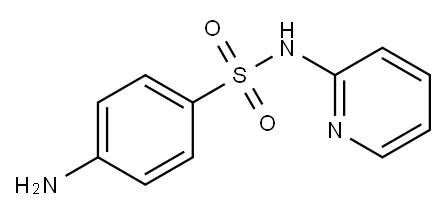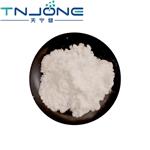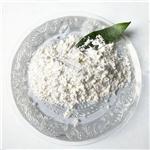Sulfapyridine is a sulfonamide antibiotic with antibacterial and anti-inflammatory activities. It is also a metabolite of sulfasalazine formed through bacterial conversion in the colon. It is active against strains of Y. enterocolitica and Salmonella (MICs = 3.1-25 and 25-100 μg/ml, respectively), as well as S. aureus (MBC = 0.8 μM). It is an inhibitor of recombinant P. carinii dihydropteroate synthetase (DHPS; IC50 = 0.18 μM). Sulfapyridine scavenges peroxyl radicals in an oxygen radical absorbance capacity (ORAC) assay. It inhibits histamine release induced by compound 48/80 from isolated rat peritoneal mast cells in a dose-dependent manner. Sulfapyridine (1 μg/kg) also inhibits compound 48/80-induced systemic allergic reaction in rats. Formulations containing sulfapyridine have previously been used in the treatment of dermatological conditions and ulcerative colitis.
antibacterial, dermatitis herpetiformis therapy
Used in treatment of dermatitis herpetiformis; antibacterial.
ChEBI: A sulfonamide consisting of pyridine with a 4-aminobenzenesulfonamido group at the 2-position.
Like all sulfanilamides, this drug possesses antibacterial activity with respect to strepto�cocci, pneumococci, staphylococci, meningococci, gonococci, colon bacillus, pathogenic
dysentery, and so on. It is a long-lasting drug. Synonyms of this drug are bacillopirin,
plurazol, sulfidin, and thiaseptol.
Sulfapyridine’s plasma half-life is 9 hours.This compound is a white, crystalline, odorless, and tastelesssubstance. It is stable in air but slowly darkens on exposureto light. It is soluble in water (1:3,500), in alcohol(1:440), and in acetone (1:65) at 25°C. It is freely soluble indilute mineral acids and aqueous solutions of sodium andpotassium hydroxide. The pKa is 8.4. Its outstanding effectin curing pneumonia was first recognized by Whitby; however,because of its relatively high toxicity, it has been supplantedlargely by sulfadiazine and sulfamerazine. Severalcases of kidney damage have resulted from acetylsulfapyridinecrystals deposited in the kidneys. It also causes severenausea in most patients. Because of its toxicity, it is usedonly for dermatitis herpetiformis.
Sulfapyridine was the first drug to have an outstandingcurative action on pneumonia. It gave impetus to the studyof the whole class of N1 heterocyclically substituted derivativesof sulfanilamide.
Odorless or almost odorless white or yellowish-white crystalline powder. Very slightly bitter taste. Aqueous solution is neutral.
Sulfapyridine is an amino acid. Slowly darkens on exposure to light . Soluble in both acidic and basic aqueous solutions
Flash point data for Sulfapyridine are not available; however, Sulfapyridine is probably combustible.
Moderately toxic by intraperitoneal and intravenous routes. Slightly toxic by ingestion. Experimental reproductive effects. Human mutation data reported. Questionable carcinogen with experimental tumorigenic data. When heated to decomposition it emits very toxic fumes of NO, and SOx.
Sulfapyridine, N1
-(2-pyridyl)-sulfanilamide (33.1.21), is also synthesized
by an analogous scheme from 4-acetylaminobenzenesulfonyl chloride and 2-amino pyridine.
Crystallise sulfapyridine from 90% acetone and dry it at 90o. Its solubility in Me2CO, EtOH and H2O is 1.5%, 0.22% and 0.02%, respectively. [Winterbottom J Am Chem Soc 62 160 1940, Beilstein 22 III/IV 3978.]



